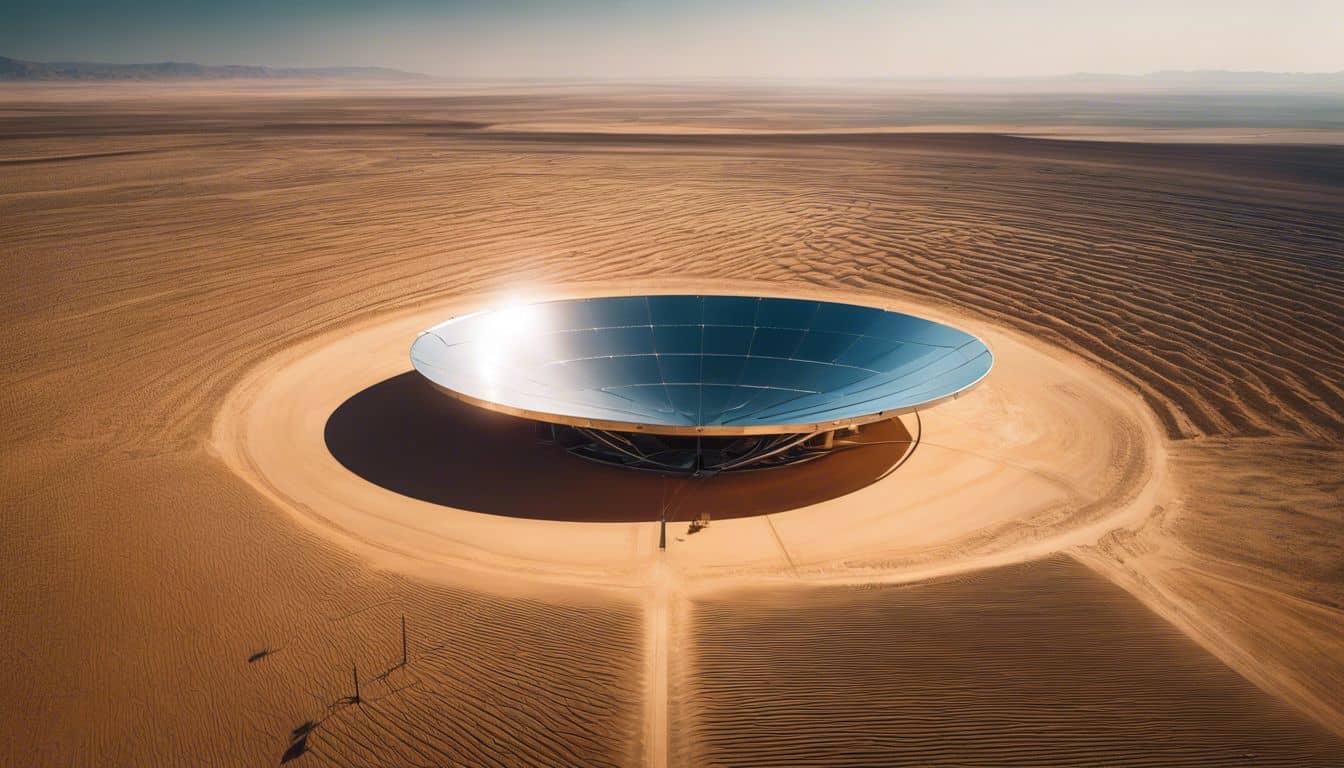Concentrated Solar Power (CSP) technology has made significant strides in recent years, positioning itself as a key player in the renewable energy landscape. As the world seeks sustainable solutions to combat climate change, innovations in CSP are paving the way for more efficient, cost-effective, and versatile solar energy systems. This article explores the cutting-edge advancements shaping CSP’s future and its potential to revolutionize the renewable energy sector.
Advanced Solar Concentrators
The heart of any CSP system lies in its ability to concentrate sunlight effectively. Recent innovations have led to significant improvements in solar concentrator designs:
- Improved parabolic trough systems: Engineers have developed more efficient parabolic troughs with enhanced reflective surfaces and structural designs that reduce material costs while improving solar concentration.
- Next-generation heliostat designs: New heliostat technologies feature advanced tracking systems and lightweight materials, increasing efficiency and reducing installation costs.
- Linear Fresnel reflector advancements: Innovations in Linear Fresnel technology have led to more compact designs and improved optical efficiency, making them increasingly competitive with other CSP technologies.
These advancements are contributing to the global trends in concentrated solar power adoption, as more countries recognize the potential of CSP in their energy mix.
High-Efficiency Receivers
Receivers play a crucial role in converting concentrated sunlight into usable heat. Recent innovations include:
- Novel materials for improved heat absorption: Researchers have developed new materials with enhanced thermal properties, allowing for higher operating temperatures and improved efficiency.
- Advanced coatings: Cutting-edge coatings are being applied to receivers to reduce heat loss and increase overall system efficiency.
- Volumetric air receivers: These innovative receivers use porous materials to absorb solar radiation more effectively, leading to higher temperatures and improved thermal efficiency.
- Particle receivers: A promising new technology, particle receivers use small ceramic particles to absorb and transfer heat, potentially allowing for much higher operating temperatures than traditional molten salt systems.
Thermal Energy Storage Breakthroughs
One of CSP’s key advantages is its ability to store thermal energy for use when the sun isn’t shining. Innovations in this area include:
- Molten salt innovations: Researchers are developing new salt mixtures that can operate at higher temperatures, increasing energy storage capacity and system efficiency.
- Phase change materials (PCMs): These materials can store and release large amounts of energy during phase transitions, offering the potential for more compact and efficient storage systems.
- Thermochemical storage systems: This emerging technology uses reversible chemical reactions to store and release heat, potentially offering higher energy density than traditional storage methods.
These advancements in thermal storage are critical for making CSP a reliable baseload power source, capable of providing electricity 24/7.

Power Block Enhancements
Innovations in the power generation side of CSP plants are also driving efficiency improvements:
- Supercritical CO2 power cycles: These advanced power cycles promise higher efficiencies and more compact power blocks compared to traditional steam turbines.
- Advanced steam turbine designs: New turbine designs are pushing the boundaries of efficiency in CSP plants.
- Integration with combined cycle systems: Hybrid systems that combine CSP with natural gas or other power sources are increasing overall plant efficiency and reliability.
For a more detailed look at these and other innovations, check out this guide to concentrated solar power innovations.
Smart Control Systems and Optimization
The integration of advanced control systems and artificial intelligence is revolutionizing CSP plant operations:
- AI and machine learning: These technologies are being used to optimize plant operations in real-time, improving efficiency and reducing costs.
- Predictive maintenance: Advanced monitoring systems can predict equipment failures before they occur, reducing downtime and maintenance costs.
- Automated heliostat field control: Smart control systems are improving the accuracy and efficiency of heliostat tracking, maximizing energy capture throughout the day.
Hybrid Systems and Integration
CSP is increasingly being combined with other technologies to create more versatile and efficient energy systems:
- CSP-PV hybrid plants: These systems combine the strengths of both technologies, providing more consistent power output and improved overall efficiency.
- Integration with industrial processes: CSP is being used to provide high-temperature heat for industrial applications, expanding its potential beyond just electricity generation.
Conclusion
The rapid pace of innovation in concentrated solar power is driving the technology towards higher efficiency, lower costs, and broader applications. From advanced materials and smart control systems to novel storage solutions and hybrid configurations, CSP is evolving to meet the world’s growing demand for clean, reliable energy.
As these innovations continue to mature, we can expect to see CSP playing an increasingly important role in the global energy landscape. The technology’s ability to provide dispatchable renewable energy makes it a valuable complement to other intermittent renewable sources like wind and photovoltaic solar.
For those interested in seeing these innovations in action, there are numerous concentrated solar power projects around the world that showcase the latest advancements in CSP technology.
FAQ
How do Generation 3 CSP systems differ from earlier technologies?
Gen3 CSP achieves 24% higher efficiency through particle receivers reaching 800°C+ temperatures and modular tower designs. Unlike traditional systems using molten salt, Gen3 employs ceramic particles or silicon carbide foams that withstand higher thermal stress. These systems integrate directly with supercritical CO₂ turbines, eliminating steam cycle limitations and reducing water usage by 90% compared to Gen2 plants.
What operational advancements have reduced CSP costs since 2023?
Automated heliostat production lines now output 500+ mirrors daily at 50% lower cost than 2020 methods. Drone-based optical alignment systems cut field calibration time from 6 weeks to 72 hours. The DOE’s 2024 report shows these innovations reduced total installed costs to $3,800/kW for tower systems – a 38% drop from 2020 figures.
Can CSP thermal storage outcompete lithium-ion batteries for grid reliability?
CSP’s stored thermal energy delivers 94% round-trip efficiency vs. batteries’ 85-90%, with 1/3 the cost per MWh for 10+ hour storage. Hybrid plants like Chile’s Cerro Dominador now pair 100MW CSP with 100MW PV, using salt storage to provide baseload power at $78/MWh – 22% cheaper than PV+battery alternatives in similar climates.
What new materials are enabling higher CSP operating temperatures?
Alumina-forming austenitic (AFA) steels allow receivers to sustain 750°C operations without degradation – a 150°C improvement over previous alloys. Researchers at Sandia Labs recently tested silicon carbide particle receivers achieving 965°C with 93% absorption efficiency, enabling compatibility with industrial heat demands.
How is CSP being adapted for urban environments?
Modular 5-20MW tower systems using flat-plate micro-heliostats (1m² vs traditional 15m²) now integrate into industrial zones. Dubai’s 2025 pilot project embeds these in warehouse districts, providing 650°C process heat for manufacturing while feeding excess electricity to local grids – a 70% total energy utilization rate versus 45% for standalone plants.
What financing models are accelerating CSP deployment?
YieldCo structures for CSP projects now attract institutional investors with 8-12% returns, leveraging 30-year power purchase agreements. Morocco’s Noor Midelt II combined CSP/PV plant secured €2.3 billion through green bonds with risk-mitigation clauses for solar resource variability – a first in renewable project finance.
How does AI optimize CSP plant performance?
Neural networks analyze real-time DNI forecasts, thermal storage levels, and electricity prices to optimize power block operations. Spain’s Gemasolar plant uses Siemens’ MindSphere platform, achieving 14% higher annual revenue through dynamic market bidding while maintaining component temperatures within 2% of ideal parameters.
What policy changes are impacting CSP adoption?
The EU’s 2024 Net-Zero Industry Act mandates 40GW of dispatchable renewables by 2030, prioritizing CSP-hybrid projects. New U.S. Treasury guidelines allow CSP plants to claim 45% investment tax credits when paired with industrial heat offtakes, mirroring incentives previously reserved for carbon capture systems.
How does CSP compare to green hydrogen production?
High-temperature CSP (750°C+) enables thermochemical hydrogen production at 58% efficiency – double electrolysis’ typical 28-32%. Saudi Arabia’s NEOM project combines 2GW CSP with cobalt ferrite reactors, targeting $2.50/kg hydrogen production costs versus $4-6/kg for PV-powered electrolyzers.

Leave a Reply